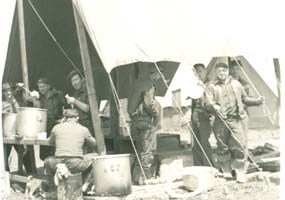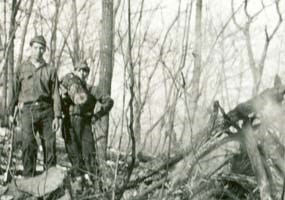
Photo donated by Jack King. The first contingent of Civilian Conservation Corps (CCC) workers arrived at Catoctin on April 1, 1939. The recruits lived in canvas tents pitched in a wooded area adjacent to the central garage unit in what is today Camp Round Meadow. They transferred to barracks as soon as they built them.
Enlistment was for three months with re-enlistment possible. Young recruits were issued oversized uniforms as prior experience had proven that hard work and adequate food would soon enlarge their bodies. The program aimed to build useful citizens by instructing these young men to use tools, take orders, respect their supervisors and to give an honest day's work. The objectives, to "promote conservation, secondly to instill and develop leadership abilities, third to train young men in at least one skill enabling them to get a job in the future," raised expectations that the men would develop social, educational and personal skills, a work ethic, self-discipline and citizenship. The recruits were supervised by "local experienced men" known as LEM's.

Project Director Mike Williams had developed plans for reforestation of the mountain. He requested that the Maryland Forestry Department provide 100,000 native trees of which a minimum of 25% were to be oak. The state was unable to provide these trees but Williams eventually secured 2,000 red maple and 2,000 pitch pine trees that were planted. The CCC rehabilitated 800 acres of fields. Strips of lespedeza and grains were planted on the contours for the benefit of quail, turkeys, rabbits, and song birds. Forest encroachment was controlled by planting strips of grain along the edge of the fields. Soon, the diversity and numbers of wildlife increased. Stream improvement projects on Big Hunting Creek and Owens Creek were initiated in 1939. Pools were deepened to provide cool water and cover for the fish. As a result, sport angling improved. Fishermen were pleased that the natural appearance of the stream was retained. Native trees, that were obtained later in 1939, were planted to obliterate open areas created by construction and to reclaim old logging roads. In August, the corpsmen dug the water system for the visitor center, built the dry stone walls behind the building, built guardrails and landscaped the area. Director Mike Williams considered this project to be the finest work completed in the park. Gettysburg National Military Battlefield was undergoing a period of restoration at this time. The CCC retrieved old wooden fences from deep in the forest to assist in this effort. These aged rails gave a realistic appearance to the battlefield scene. The corps helped nature tighten her grasp on the area as the program wound down in 1940 and 1941. Over 75 openings created by man's intrusion were blocked and made inaccessible to vehicles. Old roads were broken up and covered with topsoil. As a result, rubbish dumping in the park was reduced. The Catoctin CCC unit completed their final project in 1941 with the construction of two trailside shelters. These shelters were built along the Appalachian Trail in nearby Washington County. The numbers of young men seeking employment dwindled in 1941 with the onset of World War II. The Catoctin CCC Camp closed November 7, 1941. Since that time, the National Park Service has continued to promote conservation and preservation of natural and cultural resources. |
Last updated: May 8, 2020
